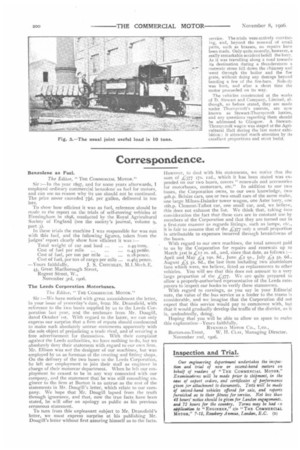Correspondence.
Page 18

If you've noticed an error in this article please click here to report it so we can fix it.
Benzolene as Fuel.
The Edit 07, " THE COMMERcIAL, MOTOR."
Sir :—In the year 1897, and. for some years afterwards, I employed ordinary commercial benzolene as fuel for motors, and can see no reason why its use should not be continued. The price never exceeded 70. per gallon, delivered in ton lots.
To show how efficient it was as fuel, reference should be made to the report on the trials of self-moving vehicles at Birmingham in 1898, conducted by the Royal Agricultural Society of England (see the society's journal, volume 9, part 3).
In these trials the machine I was responsible for was run with this fuel, and the following figures, taken from the judges' report clearly show how efficient it was :— Total weight of car and load ... ... 2.49 tons.
Cost of fuel per mile ... 0.45 pence.
Cost of fuel, per ton per mile ... ... 0.18 pence. Cost of fuel, per ton of cargo per mile ... o.465 pence.
—Yours faithfully, J. S. CRITCHLEY, 45, Great Marlborough Street, Regent Sfreet, W., November 3rd, 1906.
The Leeds Corporation Motorbuses.
The. Editor, " THE COMMERCIAL MOTOR."
Sir :—We have noticed with g-real astonishment the letter, in your issue of yesterday's date, from Mr. Dransfield, with reference to the two buses supplied by us to the Leeds Corporation last year, and the enclosure from Mr. Dougill, dated October tat. With regard to the latter, we can only express our surprise that a firm of repute should condescend to make such absolutely untrue statements apparently with the sole object of prejudicing a trade rival, and of securing a free advertisement for themselves. With their complaint against the Leeds authorities, we have nothing to do, but we absolutely deny their statement with regard to our own firm. Mr. Ellison was not the designer of our machines, but was employed by us as foreman of the erecting and fitting shops. On the delivery of the two buses to the Leeds Corporation, he left our employment to join their staff as engineer in charge of their motorcar department. When he left our employment he ceased to be in any way connected with our company, and the statement that he was still consulting engineer to the firm at Burton is as untrue as the rest of the statements in Mr. Dougill's letter, which relate to our cornpany. We hope that Mr. Dougill lapsed from the truth through ignorance, and that, now the true facts have been stated, he will offer an apology as public as his previous erroneous statement,
To turn from this unpleasant subject to Mr. Dransfield's letter, we must express surprise at his publishing Mr. Dougill's letter without first assuring himself as to the facts.
However, to deal with his statements, we notice that the sum of 4'377 17s. x id., which it has been stated was expended OD our two buses, covers " renewals and accessories for motorbuses, motorcars, etc." In addition to our two buses, the Corporation owns, to our own knowledge, two 4oh.p. Belsize cars, one or two small cars of the same make, one large Milnes-Daimler tower wagon, one Aster lorry, one thh.p. Clement-Talbot car, one small car, and, we believe, this does not exhaust the list. We think that, taking into consideration the fact that these cars are in constant use by members of the Corporation and that they are turned out in a first-rate manner as regards fittings, such as lamps, etc., it is fair to assume that of the „377 only a small proportion is attributable to expenses incurred through breakdowns of the buses.
With regard to our own machines, the total amount paid to us by the Corporation for repairs and renewals up to March 3Ist is 4'12 25. ad., and, since that date, as follows :—
April and May 4-4 195. 8d., June .4.2 95., July 5s. 6d., August Ls 55. 8d., the last item including two aluminium fans which were, we believe, fitted as replacements to other vehicles. You will see that this does not amount to a very large proportion of the -L377. We are quite prepared to allow a properly-authorised representative of the. Leeds ratepayers to inspect our hooks to verify these statements. With regard to earnings, as you say in your Editorial note, the value of the bus service as a feeder to the trams is considerable, and we imagine that the Corporation did not expect that this service would pay to commence with, but that it would gradually develop the traffic of the district, as it is, undoubtedly, doing.
Hoping that you will be able to allow us space to make this explanation—Yours faithfully,
RYKNIELD MOTOR Co., LTD., Burton-on-Trent, W. II. CLAY, Managing Director. November and, rgo6.
























